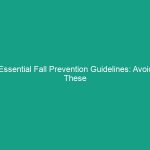Good Morning Team!
Today, we are here to discuss an essential topic in our Workplace Safety protocol: Essential Guidelines: Recognized Versus Unrecognized Hazards Explained. Understanding the difference between recognized and unrecognized Hazards is not just a regulatory requirement; it is vital for your Safety and well-being on the job. Let’s dive into why this topic is so critical for each of us.
Understanding Recognized Versus Unrecognized Hazards
Recognized hazards are those that are well-documented and understood within our industry. These are the risks we are aware of and have established protocols to manage. In contrast, unrecognized hazards are risks that have not been identified or fully understood—often because they are new, evolving, or simply overlooked.
Why is this important? A significant proportion of workplace incidents arise from unrecognized hazards. By acknowledging and addressing both types of hazards, we can create a safer work Environment for all.
Some common misconceptions include the belief that just because a hazard is not recognized, it poses no real risk. This could not be further from the truth. Many unrecognized hazards can lead to severe injuries or even fatalities if not addressed promptly.
Key Hazards, Risks, and Safety Considerations
Let’s take a closer look at some specific hazards associated with recognized and unrecognized risks.
- Recognized Hazards: These include things like slips, trips, and falls, exposure to harmful substances, and machinery Operation risks.
- Unrecognized Hazards: These might involve new technology that hasn’t been thoroughly assessed for safety, workplace stressors leading to mental health issues, or even ergonomic risks that have not been formally analyzed.
The consequences of ignoring these hazards can be grave. For instance, a slip on a wet floor is a recognized hazard with established safety protocols, while unrecognized ergonomic issues may lead to chronic pain and long-term disability.
Best Practices, Procedures, & Actionable Advice
So, how can we effectively manage both recognized and unrecognized hazards? Here are some Best Practices to follow:
- Regular Training: Ensure that you are up to date with safety training. Regular refreshers can help keep recognized hazards top of mind.
- Risk Assessments: Conduct periodic risk assessments to identify any unrecognized hazards. This can be done through surveys, audits, and employee feedback.
- Encourage Reporting: Foster a culture where employees feel comfortable reporting potential hazards, recognized or unrecognized, without fear of reprisal.
- Implementation of Controls: Once hazards are identified, take immediate action to implement appropriate safety controls, whether it’s PPE, training, or redesigning workflows.
Let’s consider a brief case study: A manufacturing facility recently experienced a series of ergonomic injuries that were unrecognized until a thorough assessment was conducted. By involving employees in the assessment process, they were able to identify and mitigate risk factors leading to significant injury reduction.
Regulations, Standards, and Compliance
Compliance with health and safety Regulations is crucial for mitigating risks associated with recognized and unrecognized hazards. Familiarize yourself with OSHA Standards relevant to our industry. These regulations provide the framework for maintaining a safe workplace.
It’s important to remember that compliance isn’t just a legal obligation; it’s a commitment to your health and safety. By adhering to established safety standards, we protect not only ourselves but our colleagues as well.
Employee Engagement & Discussion
Now, I’d like to open the floor for discussion. What safety challenges have you encountered related to recognized or unrecognized hazards? How do you think we can improve our safety protocols to better address these issues?
Engaging in dialogue about safety can lead to greater awareness and innovative solutions. Your insights are invaluable in helping us create a safer workplace.
Conclusion & Key Takeaways
In summary, understanding the differences between recognized and unrecognized hazards is vital in ensuring Workplace Safety. Here are the key takeaways from our discussion today:
- Recognized hazards are documented risks, while unrecognized hazards are those we may not be fully aware of.
- Ignoring unrecognized hazards can lead to severe injuries.
- Regular training, risk assessments, and a culture of reporting are essential for safety.
Let’s commit to prioritizing safety by recognizing the hazards around us—both known and unknown. Thank you all for your attention and dedication to safety. Together, we can create a safer work environment for everyone.


